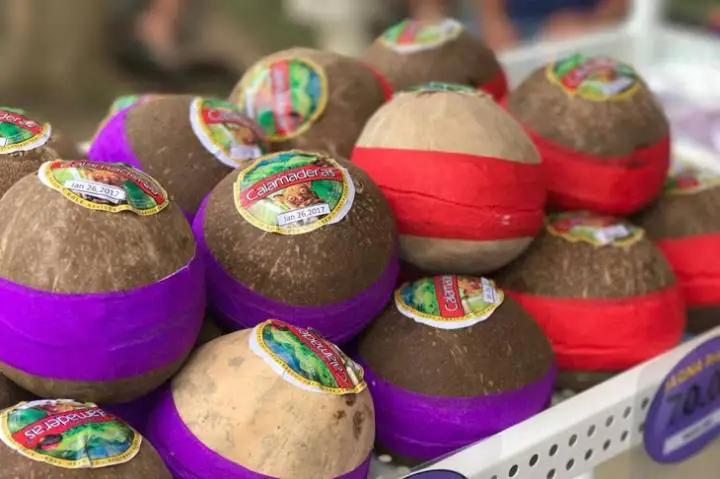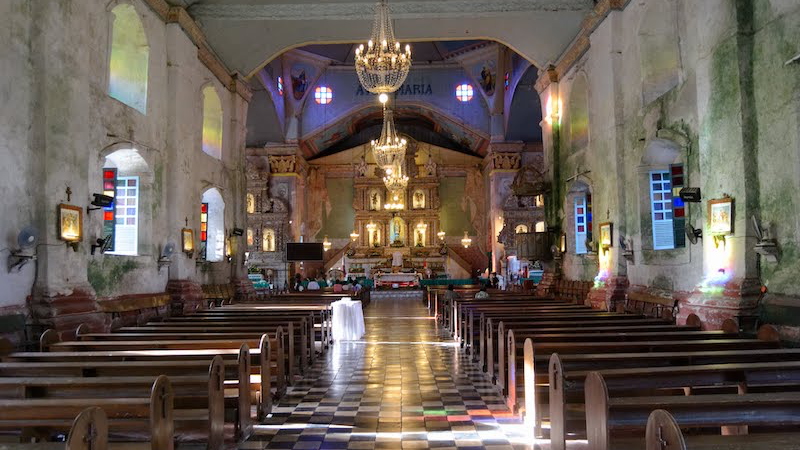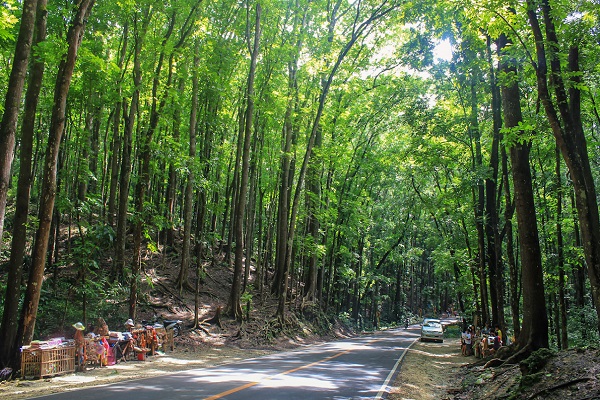- Bohol
- What to Do in Bohol
- Filipino Cuisines
- Ube or Purple Yam
Exploring the Rich Heritage of Ube or Purple Yam in Bohol
Secure your Cebu Bohol ferry tickets today to start your unforgettable journey!
Bohol's ube and its significance
Bohol's ube, the vibrant purple yam, holds a rich heritage that goes beyond its delicious taste. In this article, we'll take a journey into the history and cultural significance of ube in Bohol, uncovering its roots and exploring why it has become such an integral part of the province's identity.
When we talk about ube in Bohol, we're diving into a crop that has been cultivated for generations. Its importance as a staple crop cannot be overstated. It has sustained the people of Bohol, providing nourishment and livelihood. Ube holds a special place in the agricultural landscape of the province, shaping the way of life for many communities.
But ube is not just a crop; it is woven into the very fabric of Bohol's folklore and traditions. Stories and legends have emerged, telling tales of this remarkable yam. It's fascinating to discover the rituals and customs associated with the cultivation and consumption of ube. From planting to harvest, there are age-old practices that have been passed down through generations, giving ube a mystical quality.
In Bohol, ube is not just a vegetable; it is a symbol of resilience and abundance. It has weathered storms and hardships, providing sustenance during times of scarcity. The people of Bohol hold ube in high regard, recognizing its role in their cultural heritage. It is not uncommon to find ube as an essential part of festivals and celebrations, where it takes center stage, proudly representing the traditions and spirit of the province.


As we explore the historical and cultural significance of ube in Bohol, we begin to see how it has shaped the culinary landscape as well. Ube-inspired dishes and treats are abundant, showcasing the creativity and skill of local cooks and chefs. From traditional recipes passed down through generations to innovative creations that push the boundaries, ube has become synonymous with Bohol's culinary scene.
While the heritage of ube in Bohol is strong, it is not without its challenges. As the world changes, so does the agricultural landscape. Preserving and promoting the cultivation of ube becomes crucial to ensure its continued existence. Efforts are being made to protect and sustain the ube industry, supporting local farmers and raising awareness about the unique qualities of Bohol's ube.
Recommended Bohol Philippines Tours
[ Bohol Sight Seeing Day Trips - Check Out Availability ]
[ Full Day Cruise and Sailing Tours - Check out Availability ]
[ Full Day Adventure Tours - Check out Availability ]
Discover more of Bohol's natural wonders through our recommended tours. Click on the links below to embark on unforgettable adventures:
Ready to explore the beautiful islands of Cebu and Bohol? Secure your ferry tickets today through 12go and start your unforgettable journey!
Ube in Folklore and Traditions
In Bohol, ube not only fills plates with its delightful flavor but also weaves itself into the fabric of local folklore and traditions. Let's explore the enchanting world of ube in Bohol's folklore and the rituals associated with its cultivation and consumption.
Bohol is the largest producer of Ubi (Yam)
The Ubi Kinampay (purple yam) is a special variety of tuber because of its aroma.
Ubi is Bohol’s sacred crop. According to a traditional story, Ubi saved the Boholanos during famine and war as its shelf life is long and the people were not able to plant rice. For this reason, Boholanos consider it as a gift from God and the Ubi should be kissed if one drops it accidentally.
Visit the Natural History Gallery of the Bohol to learn more.
When it comes to local myths and legends, ube takes on a mystical quality. Stories have been passed down through generations, weaving tales of magical origins and extraordinary powers associated with this humble purple yam. Ube becomes more than just a vegetable—it becomes a captivating character in the rich tapestry of Bohol's folklore.
Beyond the myths, rituals and customs are deeply ingrained in the cultivation and consumption of ube. From planting to harvest, a series of traditional practices are followed, often rooted in beliefs passed down from ancestors. These rituals honor the land, the crops, and the spirits that are believed to watch over the harvest. Ube is not just a crop to be harvested; it is a sacred connection to the land and the ancestors.
In Bohol, ube symbolizes resilience and abundance. It has been a source of sustenance during times of scarcity, providing nourishment to communities and helping them endure hardships. The ability of ube to thrive even in challenging conditions reflects the strength and resilience of the people of Bohol. It is a symbol of their ability to adapt and flourish, even in the face of adversity.
Culinary traditions featuring ube as a key ingredient
Moving on to the culinary realm, ube holds a special place in traditional dishes and recipes. It is a key ingredient in many culinary traditions, adding its unique flavor and vibrant color to various dishes. From savory to sweet, ube finds its way into stews, soups, desserts, and snacks. The versatility of ube in Bohol's cuisine is truly remarkable.
Traditional methods of preparing and preserving ube have been passed down through generations. Techniques such as boiling, steaming, and grating are used to unlock the full potential of its flavor and texture. In addition, ube is often transformed into jams, candies, and other delightful treats, preserving its goodness for future enjoyment.

Ube becomes a highlight of festive celebrations and special occasions in Bohol. Whether it's a wedding, a fiesta, or a family gathering, ube-laden dishes take center stage on the dining table. Its presence adds a touch of tradition and joy to these important moments, creating memories that last a lifetime.
Ube in Bohol is more than just a vegetable or a culinary ingredient. It is deeply intertwined with the province's folklore, traditions, and cultural heritage. The stories and rituals surrounding ube, along with its traditional uses in cuisine, showcase the significance and reverence that Boholanos have for this vibrant purple yam. By embracing and cherishing these aspects, the people of Bohol ensure that the rich heritage of ube continues to thrive for generations to come.
7 Ube Dishes to Indulge in When Visiting Bohol
Bohol, known for its captivating Chocolate Hills and adorable Tarsiers, holds a hidden gem as one of the largest producers of ube (purple yam) in the Philippines. This "savior crop" played a vital role in alleviating hunger in Bohol during the pre-Hispanic era. Since the year 2000, the province has been celebrating an annual Ube Festival to honor this root crop, which has become an agro-historical-geographical-religious symbol for the region. This year's festival includes a cooking competition organized by the local government unit (LGU).
During a media familiarization tour in Bohol, renowned chefs showcased their winning dishes, proving that there is much more to ube than just jam. Here are some of the standout dishes that you must try when visiting this beautiful province:
Soups:
1. Sabaw Kabaw sa Ube: Chef Ma. Christina Sulta's winning dish, Sabaw Kabaw sa Ube, is a popular carabao meat soup in Loboc, Bohol. This elevated version incorporates three types of ube—binugas for a thicker consistency, baligonhon for color, and kinampay for aroma. If you enjoy nilagang baka or bulalo, you'll love this delightful soup.
2. Ubi Law-oy: Chef Marcel Navalta from Modala Resort created this ube-infused soup with a coconut water broth. The dish features three kinds of ube, along with ube cabbage rolls, dried squid, and fried shallots.
Main course:
3. Nil "Ubi"hang Alimango with local farm greens: Another delectable creation by Chef Christina, this main course dish puts a twist on a signature Loboc dish. Mud crabs are stuffed with coconut strips and ube, then cooked in fresh buko juice. It is garnished with hamutan, a local variety of basil, adding a burst of local flavor.
4. Sinanglay: For seafood enthusiasts, Chef Rex Fermalino from Bluewater Panglao Beach Resort combines wrapped fish fillet, coconut crab sauce, and fried leeks in this mouth-watering main course dish, perfect with rice.
5. Hinalang: Catering to meat lovers, Chef Rex presents Hinalang, a smoked chicken leg quarter stewed in spicy coconut sauce. It is served with pickled chili, ube garlic mash, and toasted desiccated coconuts.
Desserts:
6. Ube coconut cake: Chef Christina's take on the popular ube cake will redefine your perception of this classic treat. The cake features layers of ube halaya and young coconut jelly covered in coconut sponge.
7. Ube surprise: For those torn between ice cream and cake, Chef Rex has the perfect solution—an Ube surprise. This dessert combines ube ice cream and cake in one delightful creation. It features a tablea sponge, homemade ube kinampay ice cream, and a kalamansi merengue flambeed in orange liquor.
Bohol is home to seven varieties of ube, including kinampay, baligunhon, kabus ok, tamisan, iniling, binanag, and binato. With such diverse options, local chefs have ample room to explore and experiment with this versatile ingredient.
Make sure to add these delectable dishes to your adventure itinerary when visiting Bohol. Your taste buds will thank you for the delightful culinary experience!
Ref: JESSICA PAG-IWAYAN
Ube as an Integral Part of Bohol's Identity
Ube has become more than just a crop or ingredient in Bohol—it has become an integral part of the province's identity. Let's explore how ube has shaped Bohol's culinary scene, inspired innovative dishes, and become a source of local pride and cultural identity.
When it comes to Bohol's culinary scene, ube plays a starring role. It has influenced and shaped the flavors of the province, becoming a beloved ingredient in traditional dishes and recipes. From savory to sweet, ube adds its distinct taste and vibrant color to a wide range of culinary delights. Chefs and home cooks alike have embraced ube, incorporating it into their creations and elevating Bohol's cuisine to new heights.
But it doesn't stop at traditional dishes. Ube has also sparked culinary innovation in Bohol. Chefs and food enthusiasts have been inspired to push the boundaries and explore new ways to showcase the versatility of this purple yam. Ube-inspired creations have emerged, blending traditional flavors with modern techniques and presentation. These innovative dishes not only tantalize the taste buds but also reflect the vibrant and dynamic culinary landscape of Bohol.
Ube has become a source of local pride and cultural identity in Bohol. It represents the unique heritage and traditions of the province. Boholanos take pride in their association with ube, celebrating its role in their history and culture. It has become a symbol of their connection to the land, their resilience, and their ability to preserve traditions in a rapidly changing world. Ube embodies the spirit of Bohol and serves as a point of unity and pride among its people.
The Modern Revival and Preservation of Ube in Bohol
However, the modern revival and preservation of ube face their own set of challenges. Changes in climate, urbanization, and other factors pose threats to the cultivation and availability of ube in Bohol. Preserving and promoting ube cultivation requires concerted efforts and initiatives. Various organizations, farmers, and the local government have recognized the importance of protecting and sustaining the ube industry. They have taken steps to overcome challenges, such as promoting sustainable farming practices and preserving traditional knowledge and techniques.
Supporting local farmers is crucial to the revival and preservation of ube in Bohol. By creating awareness about Bohol's ube heritage, consumers can make informed choices and actively support local farmers who cultivate this unique crop. Initiatives that focus on education, research, and marketing are helping to raise awareness about the cultural significance of ube and its contribution to Bohol's agricultural landscape.
Ube has transcended its role as a mere crop or ingredient in Bohol. It has become an essential part of the province's identity, shaping its culinary scene, inspiring innovation, and instilling a sense of pride and cultural heritage. The modern revival and preservation of ube require collective efforts to overcome challenges and support local farmers. By doing so, Bohol ensures that its beloved purple yam continues to flourish, keeping its cultural legacy alive for generations to come.
Bohol Showcases a Variety of Ube Specialties at Ubi Festival
The Province of Bohol recently held a successful Ubi Festival at the old Tagbilaran Airport, adapting to the new normal. Under the theme "Pagpananum ug Ubi Napuslan, Kagutom Na Dala Sa Covid19 Nabatukan" (Planting Ubi Saves from Hunger Brought by Covid19), the festival aimed to celebrate the root crop and its significance as an agro-historical-geographical-religious symbol of the province. Additionally, it sought to recognize the contributions of the local ubi farmers.
Dating back to the year 2000, the Ubi Festival is a testament to the Boholanos' fondness for the purple yam known as "ubi." The root crop played a crucial role as a "savior crop" during pre-Hispanic times when it helped alleviate hunger in the province.
Today, ubi has become a staple food for Boholanos due to its delicious taste, extended shelf life, and its versatility in creating a wide range of food products. As the largest producer of ubi in the country, Bohol is home to many ubi farmers who rely on this crop for their livelihood.
As part of the festival, a variety of ubi products were showcased, including ube jams, ube-based bibingka (rice cake), ice cream, and bread. The event strictly adhered to health and safety protocols to ensure a safe and enjoyable experience for festival-goers. Other cultural activities, exhibits, and seminars were also held to honor the root crop throughout the month.
During the festival, the Provincial Government of Bohol treated members of the media, including Philstar.com, to sample various ubi specialties. These included Roasted Ube Salad, Sabaw Kabaw sa Ube (Beef Soup with Ube), Nil Ubi hang Alimango (Crabs with Ube), Ubi Eggplant and Cream Cheese, Ubi Law-oy (Mixed Vegetable Stew), and Ubi 2 Ways with Fresh Catch, among many others.
The Ubi Festival not only highlights the unique flavor and significance of ubi in Bohol but also provides a platform to support local farmers and promote the province's agricultural heritage. It showcases the rich culinary traditions and creative use of ubi, fostering appreciation for this versatile and cherished root crop.
Check out These Other Bohol Delicacies
- Bohol Delicacies
- Pastries of Baclayon
- Purple Yam of Dauis Bohol
- Bohol Purple Yam Ubi Kinampay
- Bohol's Ubi Festival
- Filipino Cuisine- Bohol-Philippines
- Culinary Gem - Alona Beach, Panglao Island
- Products of Bohol Philippines
- Bohol Culture
- Peanut Kisses- The Best Take-Home Snack
- Calamay- Bohol's Must-Have Treat
- Bohol Shopping Souvenirs: Where to Buy the Best Gifts and Treasures
- Bohol Ube or Purple Yam
- Bohol Freshwater Fish
historical and cultural heritage of ube in Bohol
The journey into the historical and cultural heritage of ube in Bohol reveals its profound significance to the province. Ube has played a pivotal role in Bohol's history, serving as a staple crop and symbol of resilience. It is deeply intertwined with local folklore, rituals, and traditions, making it an integral part of Bohol's identity.
Through centuries, ube has left an indelible mark on Bohol's culinary scene. It has shaped the flavors of the province, inspiring traditional dishes and innovative creations that showcase the versatility of this vibrant purple yam. Ube has become a source of local pride, representing the unique heritage and cultural identity of Bohol.
Preserving and celebrating the rich heritage of ube is of paramount importance. As challenges arise, efforts to protect and sustain ube cultivation must be undertaken. Supporting local farmers and raising awareness about Bohol's ube heritage are key to ensuring its enduring legacy. By doing so, Bohol can preserve its cultural landscape and pass down the traditions associated with ube to future generations.
Let us cherish and honor the historical and cultural significance of ube in Bohol. As we savor its flavors and embrace its traditions, we celebrate the resilience, abundance, and unique identity that ube brings to this remarkable province. May the enduring legacy of ube continue to thrive, keeping Bohol's cultural heritage alive for generations to come.
Check the Bohol Tourism website for more information.
Go to homepage from Bohol Ube or Purple Yam.
Ready to explore the beautiful islands of Cebu and Bohol? Secure your ferry tickets today through 12go and start your unforgettable journey!
recommended hotel booking
Book your stay in Bohol's breathtaking surroundings through Agoda and experience the ultimate relaxation
Top 25 Sights and Attractions in Bohol
- Chocolate Hills
- Tarsier Conservation Sanctuary
- Panglao Island
- Loboc River Cruise
- Hinagdanan Cave
- Balicasag Island
- Alona Beach
- Bilar Man-made Forest
- Blood Compact Shrine
- Baclayon Church
- Bohol Bee Farm
- Anda Beach
- Sipatan Twin Hanging Bridge Loboc
- Danao Adventure Park
- Sagbayan Peak
- Butterfly Conservation Center
- Clarin Ancestral House
- Dimiao Twin Falls
- Mag-Aso Falls
- Anda White Beach
- Lamanok Island
- Rajah Sikatuna Protected Landscape
- Dauis Church
- Can-umantad Falls
- Punta Cruz Watchtower
Top 20 Destinations of Bohol
- Tagbilaran City
- Panglao Town
- Talibon Town
- Anda Town
- Loboc Town
- Dauis Town
- Ubay Town
- Tubigon Town
- Loon Town
- Jagna Town
- Alicia Town
- Carmen Town
- Getafe
- Danao Town
- Bilar
- Alburquerque
- Sierra Bullones
- Sagbayan Town
- Baclayon Town
- Antequera
Ready to explore the beautiful islands of Cebu and Bohol? Secure your ferry tickets today through 12go and start your unforgettable journey!
All Rights Reserved ©2023. Bohol Philippines Travel Guide
Address: Talibon, Bohol, Philippines


















